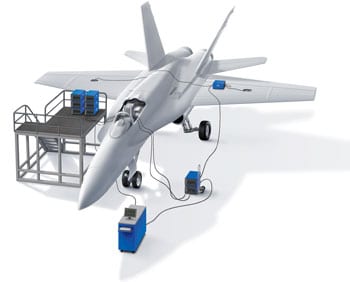Model 2650 – Distributed Wiring Harness Analyzer
What Is a Modular Test Analyzer?
The Model 2650 wiring harness analyzer incorporates modularity to meet your testing needs. The modular switching units can rack and stack in a cabinet to provide concentrated test points or be distributed around the Unit Under Test (UUT), thus eliminating long, cumbersome adapter cables. In addition, you may reconfigure the system at any time when your needs or the UUT changes.
Why Utilize Distributed Switching?
Moving the tester close to the product under test is optimal for providing efficient test operations with large UUTs. The distributed configuration eliminates unwieldy adapter cables that are expensive to rework and challenging to store.
The switch modules, such as a cockpit or wing section, can be placed remotely or stacked on a trolley for mobility and flexibility. In addition, you may want to mix racked modules with distributed modules. You make the choice that makes sense for your operation.

What Are My Configuration Choices?
DIT-MCO’s Model 2650.MTA is our most flexible test system. It allows you to utilize multiple test stations operating from a single controller, thus reducing the total cost of testing. The individual switching modules interlock, so you can stack the units for mobility and quick setup while maintaining the unit securely.
The 2650.MTA’s switching module supports up to 1,500 test points per unit, and it can be configured to suit your needs in increments of 100 points so that you won’t waste test electronics. Test interfaces on the standard unit are either 150-point ZIF or 50-pin D-sub connectors; they can also be customized to fit your needs. Special 500-point switching modules provide a small size and weight for use in locations where only a few test points are required.
Other convenient standard features in the Model 2650.MTA includes the external energization (EE) and test probe connections built into each switching module. This allows you to quickly access any point that requires power or testing with the probe.
If you require any external energization points, special switching modules configured only with EE cards accommodate this need. Just place the EE modules as you would any other switching module.
How Can I Reduce Hookup Times?
With the Model 2650’s optional random hookup feature, you don’t have to worry about cable connections to the tester. You start hooking up adapter cables in any order. An embedded ID identifies the wires and their locations. The test system automatically matches the cable hookup and runs your test program as written without modifications. What could be simpler?
Model 2650 HVA & MBA Options
Model 2650.HVA
The Model 2650.HVA provides high voltage stimulus up to 2000 VDC and 1500 VAC.
The Model 2650 HVA controller supports both high-voltage and low-voltage switching modules. You can use both in a single test setup, and the controller will disable the low-voltage switching if a high-voltage test is programmed.
Depending on the interface connector, the switching module holds up to 750 test points.
Model 2650.MBA
Integrate the 2650.MBA (Multiple Bus Architecture) into your current test and manufacturing process. The 2650.MBA tests subassemblies containing relays, switches, solenoids, lights, LEDs, and programmed power sources. Whether you need external stimulus to actuate components or add instruments, the 2650.MBA offers an efficient test solution. It eliminates unique adaptation with its direct connector-to-connector design, cutting costs and time. You can test panels, chassis, electrical racks, and other wired assemblies containing active components.
The Difference in Energization
The MBA is unique because it allows any point in the analyzer to be a switching point or an energization point. Its random access, multi-bus architecture eliminates unique interfaces.

- Portable
- Reconfigurable
- Distributed
- Minimizes Adapters
- Maximizes Space
- Multibus Option
- Random Hookup Option












